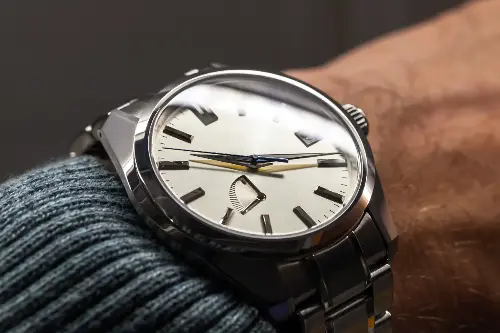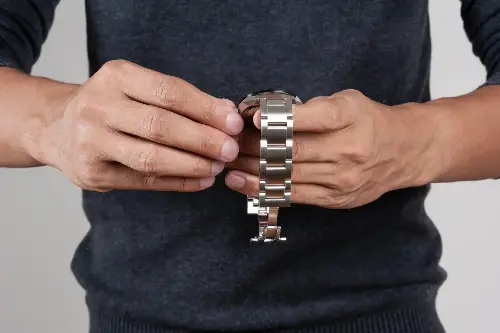In the realm of horology, timepieces are lauded not just for their ability to steadfastly mark the passing of seconds, but also for the intricate craftsmanship and innovative mechanisms that keep them ticking. Two distinct breeds have dominated the landscapes of watch aficionados' wrists: automatic and mechanical watches. To appreciate the nuances and the grandeur they embody, let us delve into the fascinating world that oscillates with the movement of gears and springs.
The Heartbeat of Time: Mechanical Watches

At the core of traditional timekeeping lie mechanical watches. These pieces are driven by a complex ensemble of mechanical parts which include springs, gears, and wheels, working together in a poetic symphony to indicate time. The calibre, or movement, of a mechanical watch is a tiny marvel, often assembled and decorated by hand, making it a testament to human ingenuity and craftsmanship.
One must wind the crown of a mechanical watch periodically to tighten the mainspring, thus powering the watch. The unwinding of this spring releases energy gradually, driving the movement and hence moving the hands. This ritual of winding is a tactile pleasure for enthusiasts, connecting them to an age-old practice of interacting with their timepiece.
A mechanical watch’s charm lies in this intricate assembly; each a handshake across history, reflecting skills passed down through generations of watchmakers. The meticulous artistry is often visible through transparent case backs, inviting wearers to gaze upon the mesmerising dance of gears and escapements within.
The Ingenious Twist: Automatic Watches

Automatic watches, often referred to as self-winding watches, are the evolutionary heirs to their purely mechanical counterparts. What sets them apart is their ability to harness kinetic energy from the natural motion of the wearer's wrist. Inside an automatic watch, a rotor, typically a semi-circular metal weight, moves freely, winding the mainspring automatically as the wearer goes about their day.
The brilliance of automatic watches lies in their self-sufficiency; eliminating the need for daily winding. It represents a convergence of utility and sophistication, making it a practical choice for the modern individual without compromising on the elaborate technical finesse of a mechanical watch.
While both types of watches may appear similar from the outside, it is what lies within their casings that distinguish one from the other. Watch enthusiasts revel in the convenience of the automatic watch, often favouring its user-friendly nature for daily wear, while purists may prefer the deliberate engagement required by a mechanical watch.
Aesthetics and Accuracy
Though much is made of their inner workings, the external beauty of mechanical and automatic watches is equally captivating. The artistry is not confined to the case back; it often extends to elaborate dials, with designs ranging from minimalist sophistication to ornate complexity.
Mechanical watches are highly regarded for their precision craftsmanship, and with that comes the expectation of accuracy. However, it's important to understand that mechanical movements are more susceptible to environmental influences such as gravity and temperature changes. An automatic watch tends to be slightly more accurate over time, thanks to the constant movement keeping the mainspring at an optimal level of tension.

Maintenance and Longevity
The longevity of both mechanical and automatic watches is commendable, with many pieces being handed down as heirlooms. Nevertheless, they require regular maintenance to ensure their continued precision. Every few years, these timepieces need to be serviced; which involves disassembly, cleaning, and oiling of the movement, to combat wear from the friction of moving parts.
Automatic watches may require less frequent winding if worn regularly, but mechanical ones invite a ritual that becomes second nature to their guardians; a bonding time with their treasured possession.
The Affair of Choice
Deciding between a mechanical or an automatic watch often boils down to personal preference. Each has its allure; whether it’s the active engagement with a mechanical watch or the mesmerising autonomous mechanism of an automatic. Many collectors find joy in the diversity, relishing the distinct experience each type provides.
The Future of Timekeeping
As technology races ahead, with smartwatches and digital masterpieces joining the fray, the mechanical and automatic watches stand as icons of a bygone craftsmanship era. Yet, their appeal remains robust, a beacon of tradition in an ocean of transience. They embody not just devices to mark time but symbolise a continuum of innovation, elegance, and the everlasting value of human touch in an increasingly digital world.
To conclude, whether a stalwart of tradition with an affinity for mechanical watches or a modern maverick drawn to the effortless charm of automatics, each collector or enthusiast speaks the language of style and sophistication. It is in the quiet ticking of these timekeeping titans that we are reminded of the relentless passage of time and the endless possibilities bound within each passing moment.
